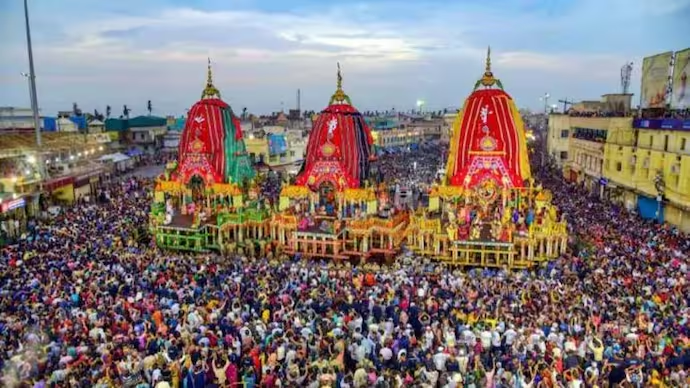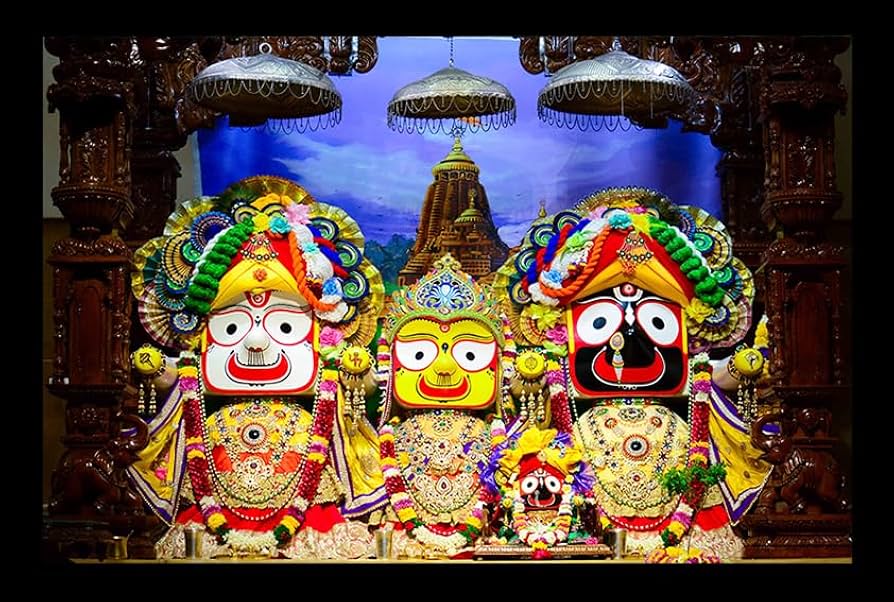Standing amidst the swirling sea of humanity on the Grand Road of Puri, I felt a surge of energy unlike anything I had ever experienced. The Jagannath Rath Yatra is not just a festival—it is a living, breathing embodiment of faith, unity, and divine ecstasy. As I prepare to return for the 2025 Yatra on June 27th, memories of my last pilgrimage fill me with anticipation and reverence.
Why the Jagannath Puri Rath Yatra Happens: The Divine Journey
The Jagannath Puri Rath Yatra, or Festival of Chariots, is rooted in ancient legends and scriptures. According to tradition, Lord Jagannath (a form of Lord Krishna), his brother Balabhadra, and sister Subhadra are taken out of the sanctum of the Jagannath Temple and placed on majestic wooden chariots. They journey to the Gundicha Temple, believed to be their aunt’s home, symbolizing a visit to their maternal relatives. This act is a re-enactment of Lord Krishna’s desire to visit his birthplace, Mathura, and is described in the Skanda Purana, Brahma Purana, and Padma Purana.
The festival is a powerful reminder of humility, service, and the transient nature of life. Pulling the chariots is considered an act of devotion, believed to purify the soul and bring immense blessings.

The Scale and Spectacle of the Jagannath Puri Rath Yatra
The Jagannath Puri Rath Yatra is one of the world’s largest religious gatherings, drawing millions of devotees from across India and beyond. The city of Puri transforms into a vibrant tapestry of colors, chants, and devotion. The main event—the procession—takes the deities along the Bada Danda (Grand Road), a three-kilometer stretch to the Gundicha Temple.
Each of the three chariots is a marvel of craftsmanship, constructed anew every year from sacred wood. Lord Jagannath’s Nandighosa is the largest, with 16 wheels; Balabhadra’s Taladhwaja has 14 wheels, and Subhadra’s Darpadalana has 12 wheels. The chariots are pulled by long ropes, and thousands of hands reach out to take part in this sacred act.
A First-Hand Spiritual Experience
My previous visit to the Jagannath Puri Rath Yatra was transformative. Arriving in Puri days ahead, I felt the city’s pulse quicken as the festival approached. The air was thick with the scent of incense, the sound of conch shells, and the collective anticipation of millions. As the chariots emerged, the crowd surged forward not in chaos, but in a shared wave of devotion. I joined in pulling the ropes, feeling an overwhelming sense of unity and surrender.
The sight of Lord Jagannath’s wide, compassionate eyes gazing out from the chariot is something I will never forget. For a moment, all distinctions of caste, creed, and nationality dissolved. I was simply a devotee, swept up in the divine current.
Who is Lord Jagannath?
Lord Jagannath, revered as a form of Lord Vishnu or Krishna, is unique in his representation. His idol, along with those of Balabhadra and Subhadra, is carved from sacred wood, with large round eyes and unfinished limbs a symbol of the divine’s acceptance of all, flaws and all. The legend tells of King Indradyumna, who, guided by a dream, commissioned the celestial architect Vishwakarma to carve the idols from a sacred neem log (Daru Brahma). When the impatient king interrupted the work, the idols remained unfinished, signifying God’s embrace of imperfection and universality.
Planning Your Visit for Jagannath Puri Rath Yatra: Tips for 2025
If you are considering attending the Jagannath Puri Rath Yatra on June 27, 2025, here are some essential tips based on my experience and expert advice:
- Book Early: Secure your travel and accommodation months in advance. Hotels fill up quickly due to the influx of devotees.
- Arrive Ahead: Reach Puri at least 2-3 days before the main event to acclimatize, explore the town, and witness preparatory rituals.
- Dress Appropriately: Wear modest, comfortable clothing suitable for the heat and humidity of June and July.
- Stay Hydrated: Carry water, wear sunscreen, and protect yourself from the sun.
- Travel Light: Avoid valuables and keep your belongings secure in the crowd.
- Respect Traditions: Follow local customs and temple guidelines for a smooth, respectful experience.
- Be Patient: The crowds can be overwhelming, but patience and a spirit of camaraderie will make your journey memorable.
Rituals and Timeline
The Jagannath Puri Rath Yatra is not a single-day event but part of a larger festival cycle:
- Akshaya Tritiya: Marks the beginning of chariot construction (April 30, 2025).
- Snana Purnima: The ceremonial bathing of the deities.
- Anavasara: The deities rest and are not seen by devotees.
- Rath Yatra: The grand procession (June 27, 2025).
- Hera Panchami, Sandhya Darshan, Bahuda Yatra: Subsequent rituals and return journey.
- Niladri Bijay: The deities return to the main temple (July 8, 2025).
The Universal Appeal
What struck me most was how the Rath Yatra transcends boundaries. People of all backgrounds, faiths, and nationalities come together in a rare display of unity and devotion. The festival’s influence reaches far beyond Odisha, with similar celebrations held in cities worldwide, reflecting its universal message of love and inclusivity.
Final Thoughts
The Jagannath Puri Rath Yatra is more than a festival it is a spiritual odyssey that leaves an indelible mark on the soul. My journey was one of surrender, awe, and profound connection with the divine and humanity at large. If you seek an experience that blends faith, culture, and the sheer energy of millions united in devotion, the Rath Yatra of 2025 awaits you.
Prepare well, open your heart, and let the chariots of the Lord carry you on a journey of a lifetime.
FAQ: Jagannath Puri Rath Yatra 2025
When is the Jagannath Puri Rath Yatra in 2025?
The Rath Yatra will take place on June 27, 2025.
What is the significance of the Rath Yatra?
The Rath Yatra commemorates Lord Jagannath’s annual journey with his siblings, Balabhadra and Subhadra, from the Jagannath Temple to the Gundicha Temple. It symbolizes the Lord’s desire to visit his devotees and the universality of divine love.
How long does the Rath Yatra festival last?
While the main procession is on one day, the festival spans several days with rituals before and after, including the return journey (Bahuda Yatra) and the final return of the deities to the main temple (Niladri Bijay).
How many people attend the Rath Yatra?
Millions of devotees and tourists from across India and the world participate, making it one of the largest religious gatherings globally.
Can non-Hindus participate in the Rath Yatra?
Yes, the chariot procession is open to all, regardless of religion or nationality. However, entry into the main Jagannath Temple is restricted to Hindus.
How can I participate in pulling the chariots?
Anyone can join in pulling the ropes of the chariots during the procession. Arrive early to find a spot, as the crowd is immense.
What are the main attractions of the Rath Yatra?
The three massive, newly constructed chariots, the vibrant procession, devotional singing, and the unique opportunity to see the deities outside the temple are major highlights.
How should I prepare for the trip?
Book travel and accommodation early, wear modest and comfortable clothing, stay hydrated, and be prepared for large crowds and hot, humid weather.
Are there any safety tips for attending?
Yes. Carry minimal valuables, keep your belongings secure, stay with your group, and follow local authorities’ instructions for a safe experience.
What are the key rituals associated with the Rath Yatra?
Key rituals include the chariot construction (Akshaya Tritiya), ceremonial bathing of the deities (Snana Purnima), the main procession (Rath Yatra), the return journey (Bahuda Yatra), and the deities’ re-entry into the temple (Niladri Bijay).
Who is Lord Jagannath?
Lord Jagannath is a form of Lord Krishna/Vishnu, worshipped in a unique wooden form along with his brother Balabhadra and sister Subhadra.
Can I visit the Jagannath Temple during the Yatra?
The temple remains extremely crowded during the festival, and only Hindus are allowed inside. However, the deities are brought outside for public viewing during the Yatra, allowing everyone to participate.
Are there similar Rath Yatras outside Puri?
Yes, Rath Yatras inspired by the Puri festival are celebrated in many cities across India and worldwide, organized by ISKCON and other organizations.
What is the best way to reach Puri for the festival?
Puri is well-connected by rail and road. The nearest airport is in Bhubaneswar, about 60 km away, with frequent trains and buses to Puri.
Is photography allowed during the Rath Yatra?
Photography is allowed during the procession on the streets, but not inside the temple premises.
If you have more questions, feel free to ask or consult the official Jagannath Temple website and local authorities for the latest updates and guidelines.
Get more information on Spirituality and Wellness on Popnewsblend.

Hi, I’m Prashant Jain — a curious soul, storyteller, and content creator at heart.I’ve always been drawn to the world of entertainment, travel, sports, health & lifestyle — not just as a writer, but as someone who genuinely lives these experiences. Whether I’m binge-watching the latest OTT series, exploring offbeat spiritual destinations in India, or diving deep into wellness routines and cricket match insights, I love sharing what I discover with like-minded readers.
PopNewsBlend is my way of blending personal journeys with meaningful stories — ones that inform, inspire, and keep you ahead of the curve. Everything I write comes from real observations, hands-on experiences, and a deep passion for understanding the world around us.
Discover more from Popnewsblend
Subscribe to get the latest posts sent to your email.








Pingback: Jagannath Puri Rath Yatra 2025 Begins Today: Live Updates, Rituals & Devotional Moments